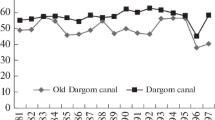Effects of human activities on the surrounding environment that lead to man-made disasters were studied. The main parameters of the cause of the accident on the scale of potential losses and hydroschemes were defined along with an estimation of the potential damage from possible accidents at hydroschemes caused by the release of the potential energy of water stored in reservoirs.
Similar content being viewed by others
References
E. N. Bellendir and N. Ya. Nikitina, “Accident risk management of hydraulic structures — problems, approaches, experience, and prospects,” in: Problems of Safety in Emergencies. Issue 3 [in Russian], VNIIG im. B. E. Vedeneeva, St. Petersburg, pp. 124 – 135 (2003).
A. B. Vasilevskii, S. N. Dobrynin, and T. S. Tikhonova, “Procedures for the expert safety evaluation of the hydraulic structures of HPPs on the basis of computer technologies,” Gidrotekhn. Stroit., No. 2, 6 – 9 (2001).
A. B. Veksler, D. A. Ivashintsov, and D. V. Stefanishin, Reliability, Social and Environmental Safety of Hydraulic Structures: Risk Assessment and Decision Making [in Russian], VNIIG im. B. E. Vedeneeva, St. Petersburg (2002).
V. I. Volkov and E. V. Dobrovol’skaya, “Analyzing risk assessment results obtained for hydraulic structures using different procedures,” Prirodoobustroistvo, No. 2, 39 – 44 (2015).
M. I. Gogoberidze, Scientific Basis for Field Studies of Dams [in Russian], Metsniereba, Tbilisi (1980).
V. Ya. Zharnitskii and E. V. Andreev, “Principles underlying the technical state monitoring of low-head earthfill dams included in the risk group according to the expert report,” Prirodoobustroistvo, No. 1, 38 – 42 (2013).
V. Ya. Zharnitskii and E. V. Andreev, “Problems associated with operational reliability and safety of earthfill dams,” Izv. Vuzov. Geod. Aerofotos., No. 1, 42 – 47 (2013).
E. P. Zolotukhin and A. P. Kuz’menko, “Monitoring of the dynamic characteristics of hydroelectric dams using microseismic vibrations,” Probl. Inform., No. 4, 24 – 33 (2009).
V. G. Zoteev, I. S. Shakhov,M. G. Morozov, and M. A. Prikhod’-ko, “Methodological principles for risk assessment at small-capacity reservoirs,” Gidrotekhn. Stroit., No. 10, 41 – 48 (2003).
M. N. Istomina, A. G. Kocharyan, and I. P. Lebedeva, “Floods: Genesis, socioeconomic and environmental impacts,” Vod. Resursy, 32(4), 389 – 398 (2005).
A. V. Liseikin, V. S. Seleznev, A. A. Bakh, and D. V. Krechetov, “Change in the natural frequencies of the dam of the Sayano-Shushenskaya hydroelectric power plant at different levels of reservoir filling,” in: Proc. All-Russia Conference Dedicated to the 100th Birthday Anniversary of Academician N. N. Puzyrev: Geophysical Methods for Studying the Earth’s Crust [in Russian], INGG SO RAN, Novosibirsk, 2014, 182 – 186.
L. K. Malik, Risk Factors of Damage to Hydraulic Structures. Safety Issues [in Russian], Nauka, Moscow (2005).
I. K. Noniev and G. A. Shainyan, “Engineering safety systems of hydraulic structures,” in: Proc. 6th Int. Conf., Moscow, November 14 – 16, 2018 [in Russian], MISI-MGSU (2018), pp. 217 – 220.
M. A. Strygina and I. I. Gritsuk, “Hydrological safety and risk assessment of hydraulic structures,” Vestn. RUDN. Inzh. Issl., 19(3), 317 – 324 (2018).
G. I. Chogovadze, I. M. Mgebrishvili, and I. E. Lomov, Enguri Hydropower Plant [in Russian], Énergoatomizdat, Moscow (1987).
R. Fell, “Estimating the probability of failure of embankment dams under normal operating conditions,” in: Repair and Upgrading of Dams: Symp. in Stockholm, Stockholm (1996), pp. 567 – 576.
S. Foti, C. G. Lai, G. J. Rix, and C. Strobbia, Surface Wave Methods for Near-Surface Site Characterization, CRC Press, London (2015).
S. O. Kurbanov and A. A. Sozaev, “Problems of ecological safety and reliability of operations of regulated river channels and protective river structures,” East. Eur. Sci. J., No. 10(2), 119 – 124 (2015).
H. Ma and F. Chi, “Technical progress on researches for the safety of high concrete-faced rockfill dams,” Engineering, 2(3), 332 – 339 (2016).
B. Mi, J. Xia, C. Shen, L.Wang, Y. Hu, and F. Cheng, “Horizontal resolution of multichannel analysis of surface waves,” Geophysics, 82(3), EN51-EN66 (2017).
P. E. Mokhtar and Jr.M. S. Freitas, “Rehabilitation for high concrete faced rockfill dam (CFRD): availability and vulnerability dam maintenance and rehabilitation II,” in: Proc. 2nd Int. Cong. on Dam Maintenance and Rehabilitation (2011), pp. 881 – 887.
J. Taipodia, and A. Dey, “Impact of strike energy on the resolution of dispersion image in active MASW survey,” in: Proc. Geo Shanghai 2018 Int. Conf.: Multi-physics Processes in Soil Mechanics and Advances in Geotechnical Testing (2018), pp. 419 – 427.
Author information
Authors and Affiliations
Corresponding author
Additional information
Translated from Gidrotekhnicheskoe Stroitel’stvo, No. 5, May 2020, pp. 36 – 42
Rights and permissions
About this article
Cite this article
Noniev, I.K., Helidze, G.K. & Shainyan, G.A. Assessment of Accidents at Storage Hydro Power Plants in Georgia. Power Technol Eng 54, 472–477 (2020). https://doi.org/10.1007/s10749-020-01234-7
Published:
Issue Date:
DOI: https://doi.org/10.1007/s10749-020-01234-7




